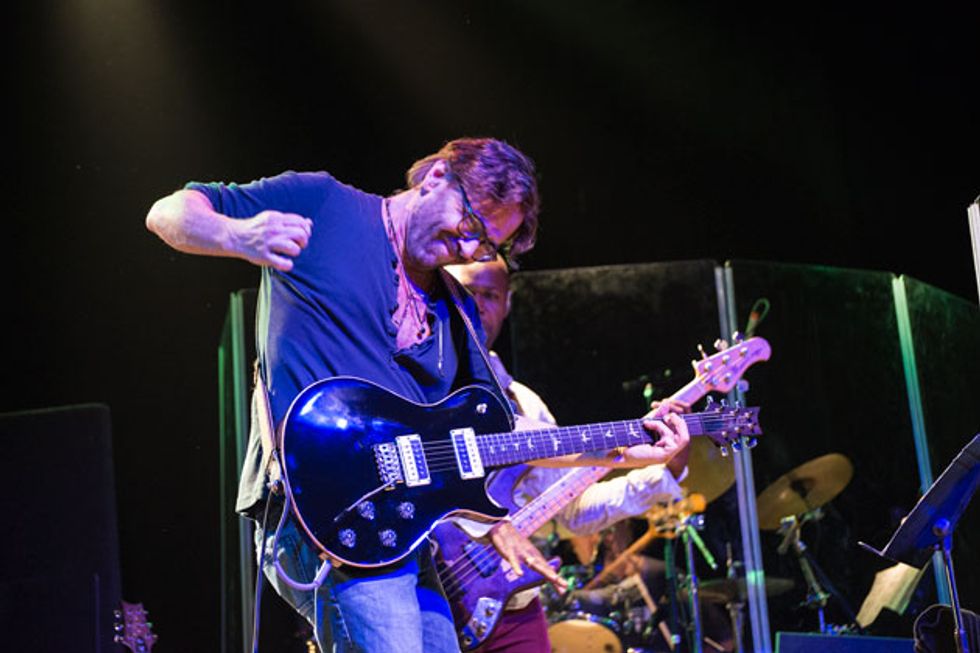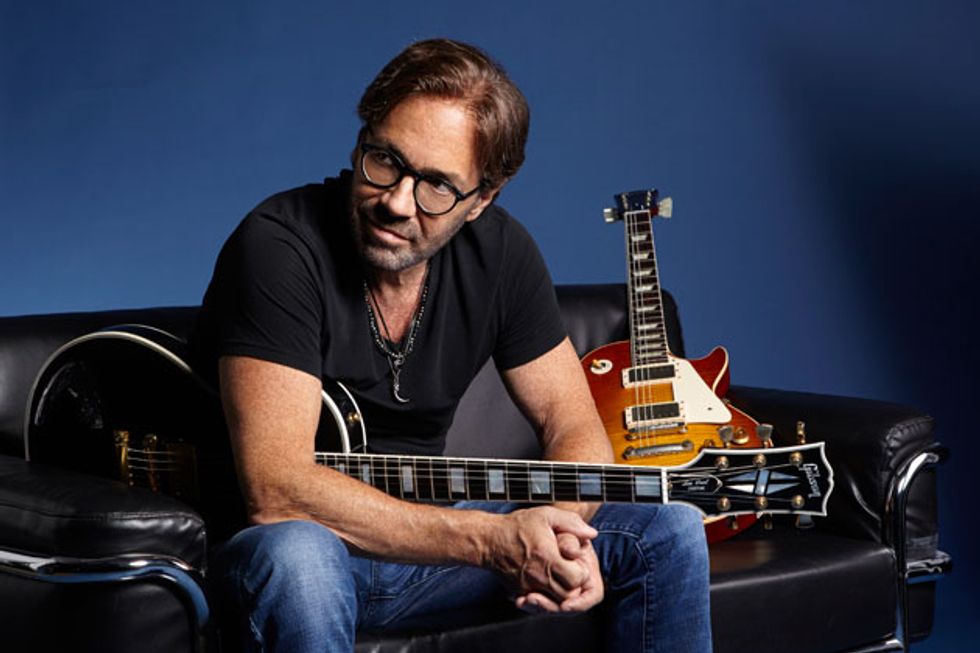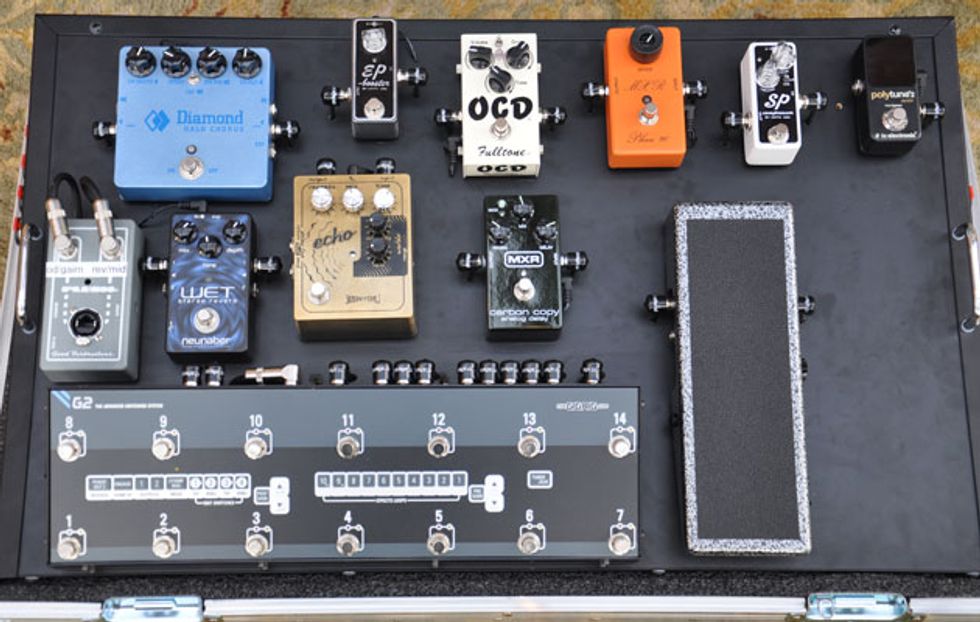Al Di Meola recalls an epiphany he had in 1974, when he was just 20 years old and performing in Europe with Chick Corea’s groundbreaking jazz-fusion group, Return to Forever. The band would break up their regular set with a brief acoustic interlude, and that’s when the thought hit him: “Hey, the audience loves this. This is something I can do all my life.”
In the years that followed, Di Meola did just that, maintaining an unplugged element in his electric shows. And in 1981 he released an all-acoustic album that sold millions: Friday Night in San Francisco, featuring his Guitar Trio mates, John McLaughlin and Paco de Lucía.
“That record solidified everything in my mind,” Di Meola says. “I envisioned an older musician, even older than I am now, playing till the end on an acoustic. I didn’t want to be that Jeff Beck guy at 72—he’s got the wall of giant amps, and he’s trying to look like he’s 25. Fuck that. If I can be known as an acoustic player now, I won’t have to make an abrupt switch later. And it paid off.”
Di Meola’s recent albums focus exclusively on acoustic playing, but this year, fans got the best of both worlds from the 61-year-old 6-string legend. Since the spring, he’s been firing up a Les Paul on his Elegant Gypsy & More Electric Tour, and on his luminous new album, Elysium, he blends 6- and 12-string acoustics with his famed ’71 Les Paul Custom.
“I wanted to do something adventurous,” Di Meola says. “More than that, I wanted to do something for guitar players. My last album [All Your Life (A Tribute to the Beatles)] had a wider appeal because of the popularity of the music. This time I didn’t care about reaching everybody. I wanted to do something advanced in terms of my composing and playing, and something I knew my fans would appreciate.”
We sat down with Di Meola during a break in his current tour to discuss his return to the electric guitar, how a painful divorce and a new pedalboard helped shape his new music, his touring and recording guitars, and whether he thinks he can get any better on his instrument.
You’re a Jersey guy. How has the Garden State shaped you musically? There’s a certain thing about musicians from New Jersey.
There is. I feel tied in with those guys—from Jersey, the Tri-State Area—in that I grew up in the ’60s and had so much great music around me. Had I grown up in Kansas or Oklahoma, I wouldn’t be who I am musically. Seven nights a week, there was amazing music happening. As a teenager I went to New York City, to the Fillmore East and jazz clubs, Latin clubs. And there were record stores, too—remember them? I grew up during the greatest music revolution ever heard, and I was in the right place for it.
You know the next note is going to be huge! Paul Reed Smith built this custom instrument for Di Meola, inspired by the guitarist’s beloved Les Pauls. Photo by Alessio Belloni
You’ve said you wrote Elysium during a difficult divorce. How did that shape your composing?
It was a horrible experience and, for the most part, extremely unfair. I was so miserable. Music saved me. It was the one thing that brought me any relief or solace—its meditative quality. Writing and playing in my studio became a form of therapy, and it was greater than the enjoyment I usually get from those activities. I had to write so I wouldn’t lose my mind.
It’s funny that the record didn’t wind up bitter and angry, because I was in the dark part of the tunnel before things went to the other side. I got into a new relationship, which is a night-and-day difference. The title of the record, Elysium, means “a place of perfect happiness,” and that’s where I got to. It was an interesting process going from dark to light.
You’ve been spending a lot of time playing acoustics, but recently you did an electric tour. Was it cool to get rocking again?
Yeah, it’s been fun. I have one of the worst cases of tinnitus, and I thought my days of electric playing were over. Just looking at an amp made me cringe—I would make a cross sign whenever I saw one. But there’s a level of expression to the electric that’s different from an acoustic, and I’ve been enjoying it. I wear a custom-made set of molds [earplugs] that cuts the dBs way, way down. You have to be sharp with your hearing, though, because they do change the sound a bit. It takes some adjustment.
In addition to his Les Paul Customs, Di Meola has been touring with a vintage sunburst Les Paul Standard,
a loaner from Gibson.
Were you playing your ’71 Les Paul Custom on tour?
I wanted to, but the damn thing’s so heavy. It’s one of the heaviest models they ever made. I’ve been playing my ’59 Custom, which is much lighter. And that’s the sweet one, the ’59. The ’71 is the aggressive monster. It’s got DiMarzios, and it’s super-loud. I used both on the new record. On tour, I also use a ’61 Les Paul Deluxe and a custom-made Paul Reed Smith—not my signature model, but one that resembles my black Les Paul. Paul was concerned about me switching over to Gibson, so he said, “I’ve gotta make you a guitar that looks like a Les Paul.” But Gibson loaned me a vintage Les Paul sunburst—I’m not sure which year—so I played that too. Oh, and a friend loaned me the ’65 Deluxe that I’d sold him, the one I played on Casino and Romantic Warrior. That got some use on the West Coast part of the tour.
You’ve said Elysium began as an acoustic album, but you added electrics after you got a new pedalboard. How did that inspire you? I got the board from Sean Haines, who used to be a guitar tech of mine. He was talking about it on Facebook, and I got intrigued. I never liked boards—I like going straight into an amp—but I can be open-minded, so I asked him to show it to me. He came over with a Les Paul, a Bogner amp, and the board. He hooked the whole thing up, and it sounded incredible—really, really beautiful. It made me think that my new music would work with these sounds.
The board has all kinds of different delays and reverbs. There’s one sound that’s sweet and swirly, like a pedal-steel guitar. It’s got boosts and different things. I’m so unfamiliar with this stuff. I just know it’s great.
Why is there no bass on the album?
Because it was supposed to be an acoustic record. The way I orchestrate the low end of the percussion takes care of that. You don’t miss it, either. I never sat and listened to the tracks and said, “Man, where’s the bass?” Actually, I tried putting bass on some things, but I had so much counterpoint going on, and the bass would’ve made it a mess. It really wasn’t necessary.
What acoustics did you play on the record?
Primarily a [nylon-string] Conde Hermanos. There’s a 12-string on the title track, and I used my [Conde Hermanos] signature model with a cutaway on the others. I have an RMC pickup on that, so sometimes you hear a bit of a bass sound. I even used a Conde Hermanos that I bought dirt-cheap in a shop in Munich. They almost gave it away. The thing could go for $40,000, and I got it for three grand.
Talk to me about writing the song “Adour.” How did you fashion the melody to work with the main riff?
The arpeggiated middle line—I call it that because it’s the most important part—came first. I can’t imagine somebody writing a melody and then applying that kind of arpeggiated counterpoint after the fact—very hard to do! I compose some harmonic structure, and that gives me license to do any kind of melody I want. But you need an interesting underpinning first. That melody was a dream to play electrically, although it was composed acoustically.
You recorded “Monsters” at 4:30 in the morning. How does it sound so fresh and energetic?
It’s just the way it came out. [Laughs.] We were in the studio, and I wanted to get it done. Yeah, I wrote that during a crisis, a really dark period. But again, I was doing this stuff as therapy—it was a cathartic experience. If it sounds exuberant, that’s good.
The song “Babylon” is bursting with ideas. It shifts in tone quite a bit. Was it conceived as one piece, or were different sections pieced together?
It was all one piece, but it was done a couple of years before writing this record. There are a couple of things that I didn’t get a chance to record because the album would have been too long. I have three or four songs ready for the next record—and there will be bass on it! [Laughs.] I’ve conceived it to be electric, whereas on this one, I put the electric on as a last-minute thing.
YouTube It
Get an up-close look at “Adour” in its initial stages as Al Di Meola plays with cellist Tina Guo and keyboardist Mario Parmisano.
You head back out on tour soon to play Elysium unplugged. Which acoustic will you use?
That’ll be my Conde Hermanos signature model, the cutaway. I put it into a Roland VG-88 [V-Guitar System], and that goes into a small AER acoustic amp. I’ll do another electric tour in October, but I don’t know which guitar I’ll use, though it’ll be a Les Paul. I’ll have that pedalboard with me—that much I know.
Is there anything you can’t do on the guitar but wish you could?
That’s interesting. What I try to do is practice a lot of the passages of my music—they’re still difficult at times. It’s not just practicing the music—they’re exercises, too. It’s always a challenge. I’m still trying to get it right, to play cleaner and faster. Not that I want to play faster, but I’ll increase the tempos if need be. That’s where technique becomes important: If you can hear it, you should be able to play it. The emotion and the ability should work together.
The players who inspire me are the ones who have the best articulate technique. They don’t have to be guitar players—they can also be pianists, people like Chick [Corea] or some other guys. They’ve got that articulate technique that I strive for. That’s the school I come from.
When you put out your Beatles tribute album, did you encounter any fans who didn’t know the Beatles’ music? As hard as that is to imagine …
There was a lot of that. Not so much in my age group, but younger fans. I remember reading some things where people said they preferred my versions of Beatles songs over the originals, because they weren’t familiar with the Beatles before me. They meant it as a compliment, but I was like, “Are you kidding me? C’mon, that’s a joke, right?”I mean, you can’t top the Beatles–don’t even try. And I wasn’t trying to. That was the smartest thing I did: take the songs and do my own interpretations. I didn’t try to imitate. Others have done that, and it’s just the wrong idea. Most of the records where they imitate are god-awful. [Laughs.] I’m happy I did that record. It was a really rewarding experience.
The pedalboard guitar tech Sean Haines assembled for Al Di Meola. Top row, left to right: Diamond Halo Chorus, Xotic Effects EP Booster, Fulltone OCD Obsessive Compulsive Drive, MXR Phase 90 (“script” reissue), Xotic Effects SP Compressor, TC Electronic PolyTune 2. Second row, left to right: Andy Fuchs custom TRS CAT-5 breakout box, Neunaber Wet Stereo Reverb, Skreddy Echo, MXR Carbon Copy Analog Delay, Hilton Pro Guitar Volume Pedal.
Bottom: GigRig G2 switching system.
Al Di Meola's Gear
Sean Haines, Al Di Meola’s guitar tech in the early ‘90s, is currently an IT consultant for IBM. Last year he posted a pedalboard photo on Facebook that piqued Di Meola’s interest and the guitarist asked to see the board. After playing through it, Di Meola was so impressed that he asked Haines to build him a duplicate.“He loved it,” recalls Haines. “He knew it could work beautifully on the new album, but more importantly, he wanted to take it on tour with him, which he’s been doing. Al likes it because a lot of the effects run in the effects loop of his amp, which keeps the effects much cleaner. They’re not going through the preamp of the Fuchs amp—they just hit the power-amp section. They have more of a hi-fi sound, which really appeals to Al.”
Guitars: 1959 Gibson Les Paul Custom, 1965 Gibson Les Paul Deluxe, 1971 Gibson Les Paul Custom, Gibson Les Paul Custom with f-holes (signature prototype), Paul Reed Smith custom model, Gibson Les Paul (sunburst, date unknown), Conde Hermanos signature cutaway (nylon-string), 1982 Conde Hermanos full-body (nylon-string), Conde Hermanos 12-string (nylon-string), Signature model Ovation steel-string acoustic, Guild 12-string, 1948 Martin D-18
Amps: Fuchs Overdrive Super 100 through Feiten vintage 2x12 cabinet (for electric guitar), AER acoustic amplifier
Effects: Roland VG-88 V-Guitar System (for acoustic guitar)
Picks and strings: D’Addario EPS510 Pro Steels regular light gauge (.010–.046), D’Addario EJ44C Pro-Arté Classical (extra-hard tension), D’Addario EJ16 Phosphor Bronze EJ16 (for Ovation acoustic, .012–.053), D’Andrea extra-heavy custom picks














![Rig Rundown: Russian Circles’ Mike Sullivan [2025]](https://www.premierguitar.com/media-library/youtube.jpg?id=62303631&width=1245&height=700&quality=70&coordinates=0%2C0%2C0%2C0)












![Rig Rundown: AFI [2025]](https://www.premierguitar.com/media-library/youtube.jpg?id=62064741&width=1245&height=700&quality=70&coordinates=0%2C0%2C0%2C0)




















 Zach loves his Sovtek Mig 60 head, which he plays through a cab he built himself at a pipe-organ shop in Denver. Every glue joint is lined with thin leather for maximum air tightness, and it’s stocked with Celestion G12M Greenback speakers.
Zach loves his Sovtek Mig 60 head, which he plays through a cab he built himself at a pipe-organ shop in Denver. Every glue joint is lined with thin leather for maximum air tightness, and it’s stocked with Celestion G12M Greenback speakers.











